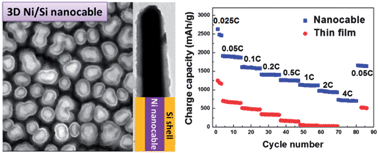Electrodeposited three-dimensional Ni–Si nanocable arrays as high performance anodes for lithium ion batteries†
Abstract
A configuration of three-dimensional Ni–Si nanocable array anodes is proposed to overcome the severe volume change problem of Si during the charging–discharging process. In the fabrication process, a simple and low cost electrodeposition is employed to deposit Si instead of the common expansive vapor phase deposition methods. The optimum composite nanocable array electrode achieves a high specific capacity ∼1900 mA h g−1 at 0.05 C. After 100 cycles at 0.5 C, 88% of the initial capacity (∼1300 mA h g−1) remains, suggesting its good capacity retention ability. The high performance of the composite nanocable electrode is attributed to its excellent adhesion of the active material on the three-dimensional current collector and short ionic/electronic transport pathways during cycling.


 Please wait while we load your content...
Please wait while we load your content...